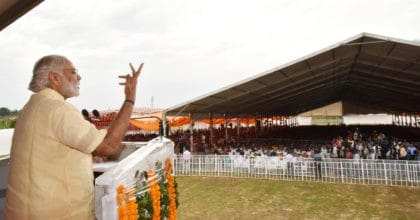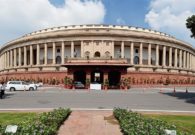India’s General Election 2019 – Reflecting on Modi’s Five Years in Power
In this two-part blog we first reflect on Modi’s five years in power before offering an insight into what the next Government has to offer once the results of the General Election have been announced on Thursday.

At first glance the 2019 General Election may appear to be a re-run of Modi vs Gandhi in 2014. However, below the surface many commentators are suggesting that the future direction of India is in play.
With voting having taken place in seven stages across India, votes are to be counted on 23rd May. In amongst this complex election and dynamic campaigns, the UK India Business Council strives to ensure businesses in the UK-India corridor are up-to-date with the largest democratic exercise in history.
But first what has Modi achieved?
weighing up Modi’s record in power
Modi’s record has its advocates and its critics. When Modi came to power, growth was reasonable though choppy, macro-economic factors unstable, and perceptions of corruption widespread. His promise was one of delivering jobs, industry, and making India a 21st century superpower. Against this backdrop we ask how he has fared.
The Good
In terms of economic policy, Modi is often attributed success in passing the bankruptcy law and the GST. Though many feel this has significant room for improvement, the GST has nonetheless gone a some way to improve the business environment. Indeed, the combination of GST and Government digitalisation drives has resulted in 93% of all Indian taxes paid online with an unprecedented 80% increase in tax collections in the last year (albeit from a low base).
Internationally, Modi has held strong in instances of perceived Chinese aggregation over border disputes, whilst his personalised approach to foreign policy appears to have built enduring international relationships. The flipside of this is that in removing India from China’s One-Belt initiative, Modi is either seen as dogmatic or patriotic over Indo-Pakistani relations depending on who you ask. Regardless, Modi is undoubtedly regarded as a strong international statesperson.
Part of Modi’s success in 2014 was his anti-corruption stance legitimised by his perceived lack of connections to the established elite of India. Whilst he has seemingly delivered Vijay Malia and Nirav Modi to the hands of justice in the eyes of many and India’s reputation is improving, there remain persistent problems in everyday administration in sectors such as the police, food distribution, and judiciary systems. At the same time, Modi may justifiably claim that the highest-levels of Government are in fact corruption-free though more needs to be done to see this filter down at the day-to-day level.
Modi came to power promising to make a tangible impact on the everyday lives of the poorest in India. On that, of the many social schemes launched, the Swachh Bharat toilets campaign can be said to have made a tangible difference to many rural people’s lives in terms of sanitation, health, and addressing this very much gendered disadvantage women face in rural society.
The Mixed
In manufacturing, it has been argued that Modi has yet to truly get to grips with the defence manufacturing industry, which in 2014 had a whole host of schemes lined up. Government initiatives still significantly drive demand. Against this backdrop, ‘Made in India’ has been a significant flagship campaign yielding impressive headline investment but has not make progress in encouraging private-sector involvement in defence. This though has been acknowledged with promises to push manufacturing further in Modi’s 2019 campaign.
Likewise, it is clear that Modi has made significant progress on ease of doing business reform during his tenue, with an unprecedented rise of 55 places in the World Bank’s ranking in the last two years. Though, again, there is a mixed picture as to whether that has filtered down to the day-to-day experience many companies face.
Whilst Modi claims mass electrification of villages across the country, meeting important promises made in the 2014 election, the reality is in fact mixed. For a village to count as ‘electrified’, only 10% of a village’s buildings and one of its public buildings need to have actually been supplied with electricity.
The launch of Ayushman Bharat, or ‘Modicare’ as it has been dubbed, has on the whole bolstered Modi’s image as a man who cares and will deliver for India’s most in need, even though it is yet to be enacted. Healthcare expenditure is a significant personal cost and addressing this will amount to the largest health insurance scheme in the world.
Modi’s offer to the 80% of employed Indians who work in the ‘unorganised’ sector was further expanded in the bold ‘interim budget’ made in January 2019 offering a ‘mega’ pension scheme called the ‘Pradhan Mantri Shram-Yogi Maandhan’ for unorganised sector workers with monthly income under £150, standing to benefit 100 million labourers and workers in the sector.
People working in this sector have increasingly experienced rising operating costs whilst their crop prices have stalled or fallen over Modi’s tenure. Modi’s offer on healthcare and pensions is significant, but many see it as indirect compensation offered too late in the day that does not address underlying structural issues in India’s agricultural sector in which direct action is sought by these voters. As such, its success in restoring Modi’s rural vote remains to be seen.
More Needed
According to a leaked version National Sample Survey Office report, the unemployment rate in India was at an all-time high of 6.1 percent in 2017-18, the highest in 45 years. Whilst this may not sound like an exceptional rate of unemployment by contemporary western standards, it is a significant problem in India with a huge population, half of whom are 25 years old or younger.
In a country where various State-level issues often play an important role in a person’s General Election voting decision, making it hard to ascertain the consistent themes that carry an Indian election, unemployment appears to be the prominent issue across India. Unfortunately for Modi, providing greater employment was visibly front and centre of his 2014 manifesto.
Whilst Modi has been credited with stabilising India’s macroeconomic fundamentals, the persistence of ‘bad debts’ has consistently lagged. A series of large bank scandals and bailouts in 2018 threatened to overshadow Modi’s premiership as election season approached. A failure to ‘clean up the banks’ through widespread sector reform, including privatisation of State banks, gave the opposition leader, Rahul Gandhi significant ammunition despite Modi’s introduction of an insolvency act positive for ease of doing business.
For many Indian’s this election is not simply one about economic outcomes or policy commitments (though these do matter), it is about the identity of their country at a time where identity politics is an increasing phenomenon globally. Many commentators posit India as at a cross-roads in deciding whether to renew its liberal and secular identity built by the Nehru Government in the wake of independence, or redefine itself as a primarily Hindu nation.
It is argued by Modi’s critics that the implications of this are perhaps even greater than one’s personal and cultural identity. Some commenters also point out that India’s institutions such as the RBI, Electoral Commission, academic institutions, and freedom of the press have not fared well in the last few years. Whilst by-passing institutions may sometimes deliver efficient outcomes and reform, if continued systematically would mark a significant political shift and concern the many Indian and UK businesses that rely on fair and stable institutions to operate.
On Balance…
Modi’s approach to the premiership has undoubtedly been ‘minimum Government, maximum governance’. However, his record in power thus far would suggest that wrestling the beast of governance has been necessary for Modi to manoeuvre himself into a place where significant changes to Government operations and bureaucracy can occur.
Perhaps this is what we can look forward to were Modi to win a second term in Government – something we will assess in the next part of this blog following the results on Thursday.
For now, it is safe to say that whilst Modi has some significant and high-profile achievements to his credit, there are areas where he has not yet delivered, such as significant job creation. Given the state of the economy Modi took over however, voters may be willing to see the big picture and understand that the promised gains may come fruition in the medium to long term.






